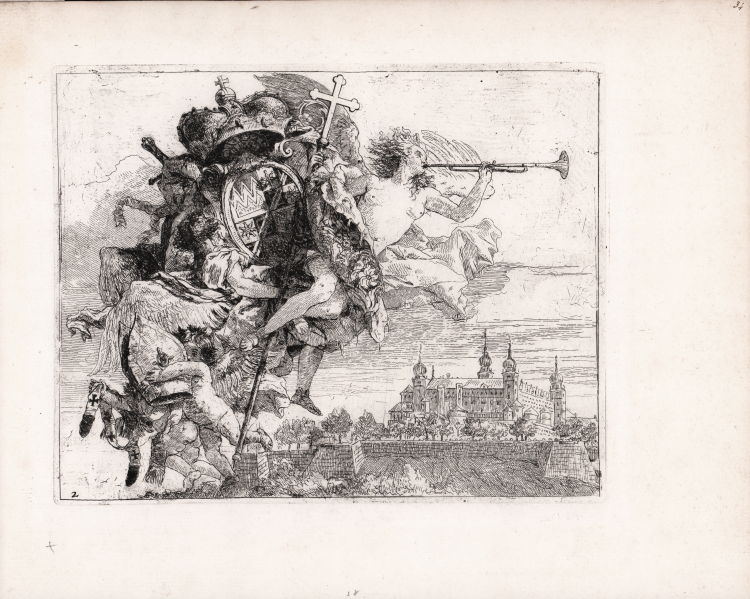



| Reference: | S41921 |
| Author | Giandomenico TIEPOLO |
| Year: | 1757 ca. |
| Measures: | 237 x 292 mm |


| Reference: | S41921 |
| Author | Giandomenico TIEPOLO |
| Year: | 1757 ca. |
| Measures: | 237 x 292 mm |
Example in the second final state, with the number 2 added lower left in the image.
Magnificent example, printed on laid paper watermarked, wide margins beyond the copper line; excellent condition.
Frontispiece of the series La Fuga in Egitto (The Flight into Egypt).
On the background of the fresh reference to the castle of Würzburg the group of angels hovers holding the coat of arms of Prince-Bishop Karl Philipp von Greiffenklau.
The frontispiece is quite rare because it was only included in the first edition of Giandomenico's Catalogue (1774).
La Fuga in Egitto, Giandomenico's etching masterpiece, includes twenty-seven plates: the dedication, the frontispiece and 24 etchings with scenes from the flight. Undoubtedly in conceiving the series Giandomenico drew inspiration from his father's works.
Bibliografia
Succi, II, pp. 538 -540, n. 45.
Giandomenico TIEPOLO (Venezia 1727 - 1804)
|
Giambattista’s eldest surviving son, he entered his father’s studio in the early 1740s, where he learnt his art by copying his father’s drawings and etchings. In 1747, aged 20, Giandomenico painted a cycle of 14 paintings, the Via Crucis (Stations of the Cross) for the oratory of the Crucifix in S Polo, Venice (in situ). He avoided any hint of Giambattista’s grandiloquence and created tender scenes that portray the suffering of Christ, the grief of his followers and the cold objectivity of the bystanders in a straightforward manner. From 1750 to 1770 Giandomenico was both his father’s assistant and associate as well as an independent artist, although at times the roles merged. From 1750 to 1753 they were preparing and executing the fresco decorations in the Würzburg Residenz, but Giandomenico was also producing a large number of his own works, such as the Institution of the Eucharist (1753; Copenhagen, Stat. Mus. Kst). This is painted in the simple and direct manner that is typical of his art both as regards subject-matter—for example the Minuet (c. 1755; Barcelona, Mus. A. Catalunya), where the pleasure of a country dance is conveyed—and composition—for example the Four Camaldolese Saints (c. 1756; Verona, Castelvecchio), in which the figures are very simply grouped together.
|
Giandomenico TIEPOLO (Venezia 1727 - 1804)
|
Giambattista’s eldest surviving son, he entered his father’s studio in the early 1740s, where he learnt his art by copying his father’s drawings and etchings. In 1747, aged 20, Giandomenico painted a cycle of 14 paintings, the Via Crucis (Stations of the Cross) for the oratory of the Crucifix in S Polo, Venice (in situ). He avoided any hint of Giambattista’s grandiloquence and created tender scenes that portray the suffering of Christ, the grief of his followers and the cold objectivity of the bystanders in a straightforward manner. From 1750 to 1770 Giandomenico was both his father’s assistant and associate as well as an independent artist, although at times the roles merged. From 1750 to 1753 they were preparing and executing the fresco decorations in the Würzburg Residenz, but Giandomenico was also producing a large number of his own works, such as the Institution of the Eucharist (1753; Copenhagen, Stat. Mus. Kst). This is painted in the simple and direct manner that is typical of his art both as regards subject-matter—for example the Minuet (c. 1755; Barcelona, Mus. A. Catalunya), where the pleasure of a country dance is conveyed—and composition—for example the Four Camaldolese Saints (c. 1756; Verona, Castelvecchio), in which the figures are very simply grouped together.
|